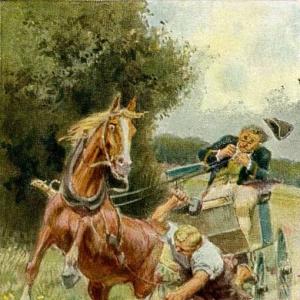Reading time: 4 min
There was once on a time a far-sighted, crafty peasant whose tricks were much talked about. The best story is, however, how he once got hold of the Devil, and made a fool of him. The peasant had one day been working in his field, and as twilight had set in, was making ready for the journey home, when he saw a heap of burning coals in the middle of his field, and when, full of astonishment, he went up to it, a little black devil was sitting on the live coals. „Thou dost indeed sit upon a treasure!“ said the peasant. „Yes, in truth,“ replied the Devil, „on a treasure which contains more gold and silver than thou hast ever seen in thy life!“ – „The treasure lies in my field and belongs to me,“ said the peasant. „It is thine,“ answered the Devil, „if thou wilt for two years give me the half of everything thy field produces. Money I have enough of, but I have a desire for the fruits of the earth.“ The peasant agreed to the bargain. „In order, however, that no dispute may arise about the division,“ said he, „everything that is above ground shall belong to thee, and what is under the earth to me.“ The Devil was quite satisfied with that, but the cunning peasant had sown turnips. Now when the time for harvest came, the Devil appeared and wanted to take away his crop; but he found nothing but the yellow withered leaves, while the peasant, full of delight, was digging up his turnips. „Thou hast had the best of it for once,“ said the Devil, „but the next time that won’t do. What grows above ground shall be thine, and what is under it, mine.“ – „I am willing,“ replied the peasant; but when the time came to sow, he did not again sow turnips, but wheat. The grain became ripe, and the peasant went into the field and cut the full stalks down to the ground. When the Devil came, he found nothing but the stubble, and went away in a fury down into a cleft in the rocks. „That is the way to cheat the Devil,“ said the peasant, and went and fetched away the treasure.
 Learn languages. Double-tap on a word.Learn languages in context with Childstories.org and Deepl.com.
Learn languages. Double-tap on a word.Learn languages in context with Childstories.org and Deepl.com.Backgrounds
Interpretations
Adaptions
Summary
Linguistics
„The Peasant and the Devil“ is a German fairy tale collected and published by the Brothers Grimm, Jacob and Wilhelm, in their famous collection „Kinder- und Hausmärchen“ (Children’s and Household Tales) first published in 1812. The Brothers Grimm were German academics and linguists who sought to preserve and document the rich oral tradition of German folklore during the 19th century. Their collection contains over 200 fairy tales, many of which have become widely known and beloved stories around the world.
The Brothers Grimm fairy tales often explore themes of morality, life lessons, and the conflict between good and evil. These stories were not originally intended solely for children, but rather for a general audience. As such, many of their stories contain darker and more complex themes compared to some modern children’s stories. Over time, however, the Grimm fairy tales have become more closely associated with children’s literature and have been adapted and sanitized to suit younger audiences.
„The Peasant and the Devil“ is a lesser-known story compared to other Grimm tales, such as „Cinderella,“ „Snow White,“ and „Hansel and Gretel.“ Nevertheless, it still offers valuable lessons and themes, as well as an entertaining narrative, that showcase the Brothers Grimm’s talent for storytelling and their dedication to preserving the rich cultural heritage of German folklore.
„The Peasant and the Devil“ offers several interpretations and themes that can be drawn from the story:
Wit and cunning versus power: The tale demonstrates that intelligence and resourcefulness can triumph over seemingly more powerful adversaries. The peasant, despite being seemingly powerless compared to the devil, uses his wit and cunning to outsmart him and secure his fortune.
Greed and its consequences: The devil’s greed for the fruits of the earth, despite already having abundant wealth, ultimately leads to his downfall. The story serves as a cautionary tale against greed and the potential consequences it can bring.
The importance of hard work and knowledge: The peasant’s familiarity with farming and understanding of crops allows him to manipulate the situation to his advantage. This highlights the importance of having a strong knowledge base and working hard to achieve one’s goals.
The deceptive nature of appearances: The story teaches that appearances can be deceptive, and that one should not underestimate others based on their appearance. The devil underestimates the peasant’s intelligence, assuming that he would not be able to outwit him. This miscalculation ultimately costs the devil the treasure.
Good versus evil: The tale can also be seen as a classic struggle between good and evil, with the clever peasant representing the forces of good and the devil representing evil. The peasant’s victory over the devil can be interpreted as a triumph of good over evil, showcasing the ultimate triumph of positive values.
Overall, „The Peasant and the Devil“ offers a variety of interpretations that explore themes of cunning, greed, hard work, deception, and the struggle between good and evil.
„The peasant and the devil“ has been adapted and retold in various forms of media throughout the years. Here are a few examples.
Animated films: The story has been adapted into several animated films, including „The Devil and Daniel Mouse“ (1978) and „The Devil and Johnnycake“ (1996).
Stage plays: „The peasant and the devil“ has been adapted for the stage, including the play „The Devil and the Peasant“ by Hungarian playwright Ferenc Molnár.
Children’s books: There are many children’s books that retell the story of „The peasant and the devil“ in simplified language and with colorful illustrations, such as „The Peasant and the Devil: A Retelling of a Grimm’s Fairy Tale“ by Charlotte Guillain.
Television shows: The story has been adapted for television shows, including an episode of the popular children’s show „Faerie Tale Theater“ in 1983.
Literary adaptations: The story has been adapted in various literary forms, including the poem „The Peasant and the Devil“ by Robert Frost and the short story „The Devil and Simon Flagg“ by Arthur Porges.
Overall, „The peasant and the devil“ has been adapted and retold in many different forms, which speaks to the enduring popularity of this classic fairy tale.
In the Brothers Grimm fairy tale, „The Peasant and the Devil,“ a cunning peasant encounters a little black devil sitting on burning coals in the middle of his field. The devil claims that a treasure lies beneath the coals and offers the peasant half of his field’s yield for two years in exchange for the treasure. The peasant agrees, but stipulates that the devil receives everything above ground, while the peasant gets what’s below. The devil agrees, unaware that the peasant has sown turnips, which grow underground.
When harvest time comes, the devil finds only withered leaves and the peasant digs up his turnips. Frustrated, the devil changes the terms, claiming that he will now take what’s underground while the peasant can have what grows above ground. The peasant agrees, but this time sows wheat, which grows above ground. When the devil returns, he finds only stubble and leaves in fury, allowing the peasant to claim the treasure. The story showcases the peasant’s craftiness in outsmarting the devil and securing a fortune.
„The Peasant and the Devil“ is a classic Brothers Grimm fairy tale that, like many other tales, conveys moral and practical lessons through simple, yet engaging storytelling. A linguistic analysis of this tale reveals several interesting aspects concerning language use, structure, and thematic elements:
Simplistic Language and Structure: The tale employs straightforward, plain language, reflecting the oral tradition from which such tales originated. This simplicity aids in the understanding and retention of the story by a wide range of audiences, including children.
Dialogue: Dialogue plays a vital role in this tale, driving the narrative forward and revealing the characters‘ intentions and personalities. The exchanges between the peasant and the Devil are particularly notable for their brevity and directness, which serve to highlight the peasant’s cunning and the Devil’s misjudgment.
Use of Repetition: The narrative structure relies on repetition of scenarios with variations, a common technique in folktales that aids memorability. The first deal, where the peasant keeps what is below ground, is mirrored with a second deal in which he secures what is above ground. This repetitive structure emphasizes the peasant’s cleverness and adaptability.
Symbolism and Motifs: The tale employs symbolic elements and common folktale motifs. For example, the Devil represents evil or temptation, while the peasant embodies cleverness and resourcefulness. The treasure is symbolic of material wealth, while the crops (turnips and wheat) reflect the fruits of labor and the natural world. There is also the motif of “the trickster,” which is central to the tale.
Themes: The linguistic choices reflect the themes of intelligence over brute power and the idea of trickery as a form of justice. The peasant’s language, such as his cunning bargaining, illustrates his mental agility and strategic thinking.
Moral Overtones: The story uses language to build a moral lesson about cleverness and the rewards of intelligence and wit. The peasant’s ability to outsmart the Devil serves as a cautionary tale about the virtues of wisdom and the pitfalls of greed.
Cultural Reflection: The language also reflects cultural values, such as the admiration of cleverness and resourcefulness in the peasant class. It underscores an egalitarian notion that intelligence is not limited to the wealthy or powerful but is available to the common people.
In summary, „The Peasant and the Devil“ uses clear, repetitive language and dialogue to convey a moral lesson through cultural symbols and themes. The tale’s linguistic elements are designed to engage listeners while also reflecting the values and lessons important to the society from which it emerged.
Information for scientific analysis
Fairy tale statistics | Value |
|---|---|
| Number | KHM 189 |
| Aarne-Thompson-Uther-Index | ATU Typ 1030 |
| Translations | DE, EN, ES, FR, PT, HU, IT, JA, NL, PL, RO, RU, TR, VI, ZH |
| Readability Index by Björnsson | 32.8 |
| Flesch-Reading-Ease Index | 78.5 |
| Flesch–Kincaid Grade-Level | 7.2 |
| Gunning Fog Index | 8.8 |
| Coleman–Liau Index | 7.8 |
| SMOG Index | 7 |
| Automated Readability Index | 7.4 |
| Character Count | 1.983 |
| Letter Count | 1.511 |
| Sentence Count | 19 |
| Word Count | 377 |
| Average Words per Sentence | 19,84 |
| Words with more than 6 letters | 49 |
| Percentage of long words | 13% |
| Number of Syllables | 482 |
| Average Syllables per Word | 1,28 |
| Words with three Syllables | 8 |
| Percentage Words with three Syllables | 2.1% |

 Facebook
Facebook  Whatsapp
Whatsapp  Messenger
Messenger  Telegram
Telegram Reddit
Reddit














